An overview of pipe connection methods: compare collet, threaded and bell-shaped options
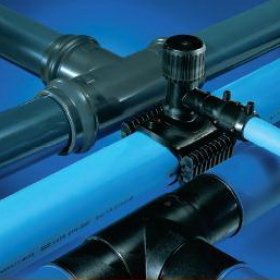
When carrying out plumbing work, very often there is a need to connect pipes. This can be done by different methods, the choice of which depends on the purpose of the pipeline, the material from which the parts are made, and other factors. For example, a socketed pipe connection is usually used to simplify installation and at the same time increase the reliability of the joints. Let's get acquainted with the features of some compounds.
Content
The nuances of the socket connection of parts
The bell-shaped method of joining parts is very simple. The edge of one pipe has a larger diameter, it is he who forms the bell, into which the end of the other element is inserted. To make the connection airtight, a special rubber ring seal is used, which is inserted into the socket, or another seal. Installation of a pipeline with connections of this type is not particularly difficult and resembles the assembly of a designer. There are varieties of bell socket.
Option # 1 - without O-ring
The method is very often used to connect sewer cast-iron pipes. Details are measured. The inserted element is laid on wooden blocks and sawed off along the intended line. The end of the outside of the part must be crackless or notched and strictly perpendicular to the axis of the pipe. The prepared pipe is inserted into the socket. The gap inside it must be closed. An oiled hemp or tarred flax is used as a sealant. The first layer is inserted into the pipe with a ring, so that the ends of the strands do not fall into the part. The sealant is choked with a hammer and a screwdriver.
The remaining layers of material are laid in the same way until approximately two-thirds of the socket depth is filled. The last layer is laid seal without impregnation, which may interfere with adhesion to the solution. The remaining distance to the end of the pipe is filled with cement mortar or silicone sealant, asbestos-cement mixture, bitumen mastic and similar compounds.
Option # 2 - with O-ring
It is considered one of the main ways to connect plastic pipes. In this case, the tightness is ensured by a rubber ring, which is clamped between the flat end of the pipe and the walls of the socket. The sealant, which can be with or without special plastic inserts, allows you to partially compensate for possible misalignment of the axes of the connected parts.However, uneven deformation of the sealing strip on the ring can cause leaks in the joint area. Therefore, the curvature of the axis should not be more than the thickness of the pipe wall per each linear meter of the pipeline.
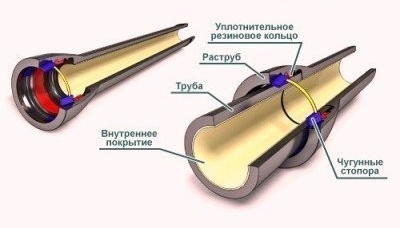
When mounting a socket connection with a sealing ring, it is necessary to monitor the alignment of the centers. Otherwise, the distortion of the pipe will provoke deformation of the seal and, as a result, insufficient sealing of the connection
Some manufacturers produce models of tees and elbows not at a straight line, but at an angle of 87 °. Thus, a pipe that is laid down under a slope enters the bell without distorting the ring. When mounting, to prevent damage to the seal at the smooth end of the pipe, a chamfer is performed and lubricated with soap, glycerin or silicone. It is forbidden to use oils. The bell-shaped connection with the o-ring is as follows:
- We check the presence of a sealing ring in the socket and chamfers at the smooth end of the pipe. We clean the parts from possible contaminants, apply lubricant.
- We place the smooth edge of the structure all the way into the socket and put a mark.
- Carefully remove the part from the socket, extending it no more than 11 mm, focusing on the previously set mark. The resulting gap will compensate for temperature changes in the length of the pipe. On average, one bell compensates for the elongation of a two-meter fragment of the pipeline.
If you want to connect pipes of different materials using this method, special adapter pipes are used.
Option # 3 - socket weld method
Contact socket welding is designed for plastic parts and is carried out using special equipment. In the process of connection, a mechanical or manual welding machine is used, equipped with special devices for heating the elements. This mandrel, designed to melt the inner surface of the part, and a sleeve that heats the outer part of the pipe.
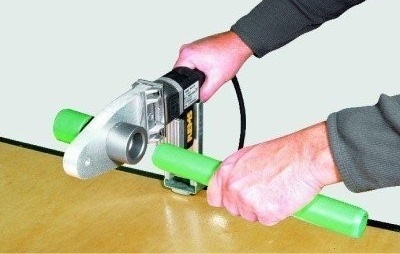
Polypropylene pipes are connected by socket welding. For this procedure, a special welding machine is used, which heats the parts to the desired temperature
The connection process is quite simple. A set of sleeve-mandrel is selected, corresponding to the diameter of the connected pipes. Devices are installed on the platform of the device and heated. Parts are put on equipment and heated to the desired temperature. Once it is achieved, the elements are quickly and accurately removed and connected with an exact movement to the stop. The connection is left motionless until the plastic cools and hardens completely.
Topic article: Do-it-yourself welding of polypropylene pipes: how to do everything accurately and professionally
Collet joining parts
The collet connection of pipes, widely used in the installation of plastic pipelines, is carried out using special devices. These are the so-called collet or clamping fittings. The device is a combination of a fitting, a pipe connecting element, and a collet, a springy split sleeve. The collet creates additional internal pressure on the pipe, pressing it to the fitting cartridge, which makes the connection tight and reliable.
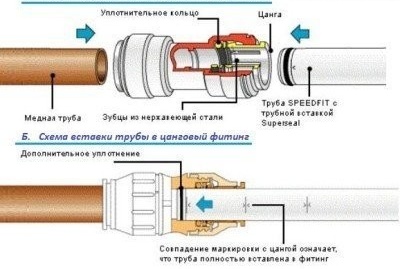
When making a collet connection, the fitting must be very carefully tightened so as not to overtighten it. Otherwise, the pipe may burst.
Installation of the connection is quite simple and does not require special equipment and skills. The main thing is to choose the right clamping fitting. It must match the type and diameter of the pipe. In some cases, a special fitting is purchased with a collet at one end and a thread or nut of the desired diameter at the other. In general, the selection of the clamping device is not difficult, since most accessories and plumbing fixtures have standard sizes.
Installation details as follows.A collet is gently inserted into the inner cavity of the pipe, and the tightening external fitting nut is twisted with an adjustable wrench. It turns out that the part is tightly clamped and hermetically fixed. With the second connected pipe do the same. During installation, it is important to remember that the collet produces quite strong pressure on the part and if you tighten the clamping nut, the pipe may burst. This is especially true for plastic parts. Therefore, it is recommended to measure the forces when tightening the nut and perform this operation with caution.
Correct threaded joint
A threaded pipe connection is a detachable joint made using a spiral or screw surface called a thread. This is one of the most common connections, due to its tightness, reliability and ease of installation. To implement it, you will need to twist two elements that have threads of suitable diameter. To separate the joint, you will need to follow the steps in the reverse order, that is, simply untwist the parts.
Pipe sections with threaded connections are usually mounted where periodic monitoring is possible. This is due to the fact that the thread over time, for various reasons, can "loose" and the mount will lose its tightness. Then you need to carry out repairs. Threads are usually rolled onto pipes using special equipment, but you can cut them manually using a die.
The operation is performed as follows:
- A part of the required size is cut with an allowance for the threaded part. The pipe is fixed in a vice so that the possibility of scrolling is completely eliminated.
- Carefully and accurately, the die bites on the end of the part. Even a slight skew when putting on the plate is unacceptable, otherwise the thread will turn out to be a curve.
- The required number of turns is cut. To facilitate the procedure, the pipe can be lubricated with machine oil. A stuck die is most likely slowed by chopped shavings. To remove it one turn is made back, after which the work continues.
Topic article: How to thread a pipe - 2 effective options for solving the problem
If you have to perform threading on a pipe located too close to a wall or another plane that does not allow a complete revolution of the tool, die holders with a ratchet mechanism are used.
Important! When making a threaded connection, a seal is usually required. In the role of a sealant can act as special tape type fum or traditional impregnated linen or hemp.
Most plumbing pipe sections are simple enough. If you follow the instructions correctly, you can perform them efficiently and quickly enough. The main thing is to correctly choose the appropriate type of connection and select all the elements necessary for it. In this case, you can be sure of the reliability and strength of the pairing.
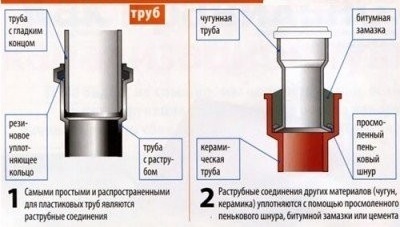
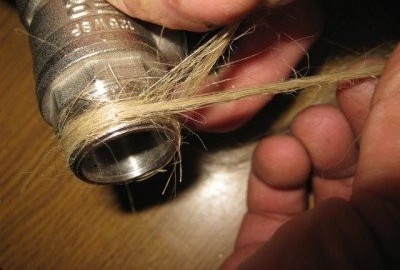

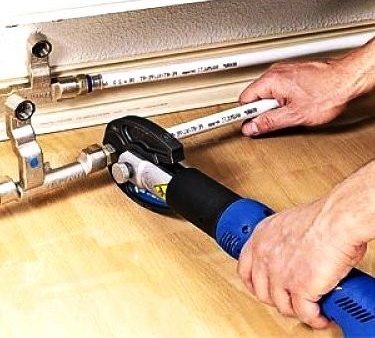
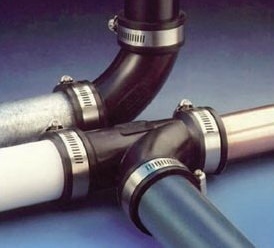
1 comment